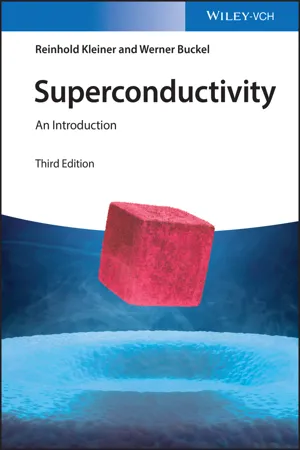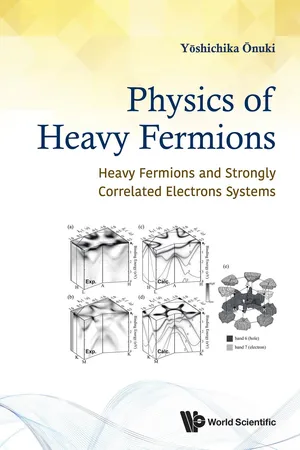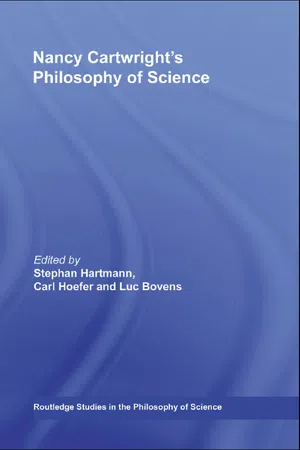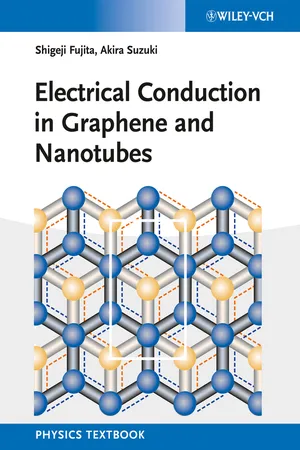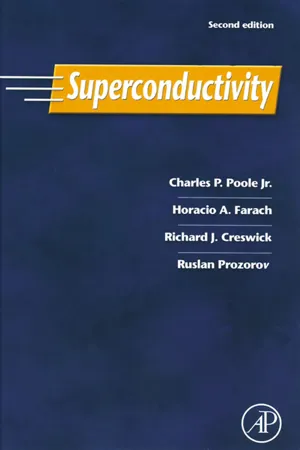Physics
Cooper Pairing
Cooper pairing is a phenomenon in which two electrons with opposite spins form a bound state at low temperatures. This pairing is due to the attractive interaction between the electrons and results in the formation of a superconductor, which has zero electrical resistance.
Written by Perlego with AI-assistance
Related key terms
Related key terms
1 of 4
Related key terms
1 of 3
10 Key excerpts on "Cooper Pairing"
- eBook - ePub
Superconductivity
An Introduction
- Reinhold Kleiner, Werner Buckel, Rudolf Huebener(Authors)
- 2015(Publication Date)
- Wiley-VCH(Publisher)
Chapter 3 Cooper PairingIn Chapter 1 , we saw that superconductivity is intimately connected with the appearance of a macroscopic coherent matter wave constituted by electron pairs. Now we must ask how this pairing is accomplished, and how in the end it results in a macroscopic quantum wave with a well-defined phase. First, we will discuss conventional superconductors (see Section 2.1 ). In the second half of this chapter, we will turn to unconventional superconductors and in particular to high-temperature superconductors.3.1 Conventional Superconductivity
3.1.1 Cooper Pairing by Means of Electron–Phonon Interaction
Following our discussion in Chapter 1 , it appears relatively easy to arrive at a theory of superconductivity based on the microscopic interaction between the electrons themselves and between electrons and the surrounding crystal lattice. However, historically such a theory was confronted with extreme difficulties. Because of the striking change of the electrical conductivity and the magnetic effects during the onset of superconductivity, one could presume that essentially one is dealing with an ordering process within the system of conduction electrons. As we saw in Section 1.1 , because of the Pauli principle the conduction electrons have fairly large energies up to a few electronvolts (1 eV corresponds to thermal energy kB T at a temperature of about 11 000 K). However, the transition into the superconducting state occurs at only a few kelvins. Hence, one had to find an interaction that could lead to ordering within the electron system in spite of the high electron energies.There exists a multitude of possible interactions between the conduction electrons in a metal. It had been imagined [1] that Coulomb repulsion between the electrons could lead to a spatial ordering of the electrons in the form of a lattice. Also [2] a magnetic interaction seemed possible. The electrons propagating through the metal lattice with impressive velocities (electrons having energies near the Fermi energy can reach velocities near 1% of the velocity of light) generate a magnetic field because of the associated currents and can then interact with each other due to this magnetic field. Other interactions can result from the structure of the electron states (allowed energy bands, see Section 1.1 - eBook - ePub
Physics of Heavy Fermions
Heavy Fermions and Strongly Correlated Electrons Systems
- Yoshichika Onuki(Author)
- 2018(Publication Date)
- WSPC(Publisher)
Chapter 6
Superconductivity
The microscopic BCS theory of superconductivity, which was proposed by Bardeen, Cooper and Schrieffer in 1957, is based on the following idea[177 ]. When an attractive interaction between fermions is present, the stable ground state is no longer the degenerate Fermi gas but a coherent state in which the electrons are combined into pairs of spin-singlets with zero total momentum (k ↑, –k ↓: Cooper pairs). A conduction electron distorts the lattice by moving in the lattice and attracting the positive ion. This distortion attracts another conduction electron. Namely, the interaction between two electrons mediated by the phonon forms the Cooper pair of the two electrons. A BCS-type superconductor has an isotropic superconducting gap which is opened over the entire Fermi surface. Superconductivity was regarded as one of the more well-understood many-body problems. The BCS-superconductivity has been, however, altered in heavy fermion superconductors. The pairing mechanism is not due to phonons. These alternative mechanisms are as follows: pairing mechanism correlated with antiferromagnetism (or antiferromagnetic fluctuations), ferromagnetism vs superconductivity, quadrupole interaction vs superconductivity, and a novel pairing state in the non-centrosymmetric crystal structure.6.1BCS superconductivity
First, we explain the basic concept of the Cooper pair[178 ]. We add two electrons of (k1 , σ1 ) and (k2 , σ2 ) on a spherical Fermi surface at 0 K, which is fully occupied by electrons up to a Fermi energy εF (= ħ2 kF 2 /2m), and then k must be larger than kF in magnitude, as shown in Fig. 6.1 . The two-electron wave function Ψ(r1 , σ1 , r2 , σ2 ) is a product of the orbital part ψ(r1 , r2 ) and spin part χ(σ1 , σ2 ). The spin is either ↑ or ↓, and the spin part χ(σ1 , σ2 - eBook - ePub
Solid State Physics
From the Material Properties of Solids to Nanotechnologies
- David Schmool(Author)
- 2016(Publication Date)
- Mercury Learning and Information(Publisher)
the most important. This was the publication of the so-called BCS theory, after its authors, Bardeen, Cooper and Schrieffer, who provided a robust quantum mechanical microscopic theory of the Cooper pair and its role in superconductivity.The pairing of electrons with opposite spins was found to be the ground state of the electron gas, where coupling was provided by an electron - phonon mechanism. This gives rise to a band gap separating the Cooper pair (superconducting) states from the single unpaired electron states in the solid. The band gap is a form of Cooper pair binding energy and is related to the critical temperature of the superconducting state. This was a major triumph of the BCS model. The BCS model was also able to cope with the Meissner - Ochsenfeld effect and the Ginzburg - Landau model. It furthermore was able to predict the flux quantization inside the superconductor.Based on the quantum mechanical description of the superconducting state, progress was made in the early 1960s in the theory and experimental fields relating to tunneling effects between superconductors and metals through an insulating barrier (Giaever tunneling) and between two superconductors (Josephson effects). In the latter an ac and a dc effect were identified. These developments permitted some of the first real applications of superconductors in the SQUID device. This is constructed from two branched of a superconductor, each containing a Josephson junction. It is found that the interference that is observed allows a measure of the coherence of the Cooper pair state and is extremely sensitive to magnetic fields penetrating the loop between the Josephson junctions. This has been used to make the worlds most sensitive detector of magnetic fields and is regularly used in the SQUID magnetometer. - Emil Zolotoyabko(Author)
- 2021(Publication Date)
- Wiley-VCH(Publisher)
Appendix 10.A . In fact, to minimize the magnitude ofVthe wavevectors of individual electrons,Ck,kandk′, must be of opposite sign. The requirement to have opposite spins originates in the Pauli exclusion principle. In this case, two electrons can be situated close to each other (see Chapter 11 ).Therefore, such quasi-particles, called Cooper pairs, will possess zero spin (i.e. they are bosons) and, hence, will obey the Bose–Einstein statistics. The latter, in contrast to Fermi–Dirac statistics for individual electrons, permits an unlimited number of particles to be in the lowest quantum state. This state is called a Bose condensate and was predicted by Einstein in 1925. A Bose condensate stands behind the superfluidity phenomenon in liquid helium, as well as behind the superconductivity phenomenon, which can be considered (in some sense) as the superfluidity of electron gas. This idea was first proposed by Fritz London in 1938. In such phenomenological approach, electron gas is assumed to be a two-component liquid with one normal component and the second one being a superconducting Bose-condensate. At T = 0, electron gas is entirely superconducting, while at certain critical temperature, Tc , it experiences the second-order phase transition into normal state. In this sense, superconductivity is a quantum-mechanical phenomenon, which reveals on a macroscopic scale.The BCS theory provided physical basis and microscopic comprehension of the superconductivity phenomenon. In particular, the quantum-mechanical calculations showed that the Cooper pair, in fact, has slightly lower energy than 2EFby an amount of Δ, which is the binding energy of two electrons forming a boson-like pair. The key parameter Δ- eBook - ePub
- Walter A. Harrison(Author)
- 2012(Publication Date)
- Dover Publications(Publisher)
In demonstrating an instability in the electron gas it suffices to find any state of the system which has lower energy than the ordinary normal state. These Cooper pairs represent such an instability of our model system. We wish now to find the ground state of the full system. This is accomplished approximately in the microscopic theory of superconductivity.9. Bardeen-Cooper-Schrieffer (BCS) Theory
In the discussion above we considered only the interaction between a single pair of electrons, though of course all electrons interact. We might at first attempt to put every electron pair in a Cooper pair state. However, this clearly violates the exclusion principle. We therefore must proceed more carefully and construct the many-electron state from the beginning.We will give the BCS variational solution of this problem. Another method is the spin-analog method due to Anderson.1It is necessary first to rewrite the electron-electron interaction in the form of the BCS reduced Hamiltonian, including only interaction between the two electrons of a pair, these electrons having opposite momentum and spin. We begin with the electron-electron interaction that we obtained in Eq. (4.58) in Sec. 4.3 of Chap. IV, and include only terms coupling such pairs. It is convenient in doing this to add to each term the conjugate-transpose term. This includes each term twice so we must divide by 2.1 Kittel, op . cit ., p. 157.We allow the summation over k to include all wavenumbers by selecting always the state k to have spin up and the state − k to have spin down, then we have not counted any pair twice. These two terms can be combined if we write k + q = k in the second term and change the sign of the dummy variable q . That sum becomesChanging the variable k to k we may combine the two terms directly.(5.58)We have collected our creation and annihilation operators together to give pair -annihilation and -creation operators. The operatorb k = Cannihilates a pair of electrons and the operator−kC kb k + = C k + C−k+ = (C −k C k )+creates the corresponding pair. In this form we see that the electron-electron interaction is explicitly attractive if the two coupled states are sufficiently near each other in energy; i.e., if both are sufficiently close to the Fermi energy. It is the attractive interaction in this energy range that leads to the instability. The energy range over which the interaction may be attractive is restricted to something of the order of the Debye energyωD - eBook - ePub
- Luc Bovens, Carl Hoefer, Stephan Hartmann, Luc Bovens, Carl Hoefer, Stephan Hartmann(Authors)
- 2008(Publication Date)
- Routledge(Publisher)
Given that there were so many pairs spread over such a large volume it made sense to think of them as not being completely correlated with one another but correlated only in a statistical sense. 23 In other words the wavefunction represented a kind of statistical ensemble where the pairs were partly independent, constituting a superposition of states with different numbers of particles. A Hartree type approximation (which does not conserve the number of particles) was used where the probability distribution of a particular state does not depend (at the level of description that is given) on the distribution of the others, something that had never been applied to electrons. This was justified by arguing that the occupancy of some one state was basically independent of whether other states were occupied. 24 In summary then the basic picture that comprises the representative model can be given in the following sentence: The foundation of superconductivity is the attractive interaction (Cooper Pairing) between electrons that results from their coupling to phonons. Once this physical picture was in place, so to speak, BCS then focussed providing a full quantum mechanical treatment that involved solving the “pairing Hamiltonian”. While this involved making use of the interpretive models that Cartwright discusses, much more was required to flesh out the complete picture, specifically details regarding the electrons described by the representative model. In the presence of this interaction the system forms a coherent superconducting ground state, characterized by occupation of the individual particle states in pairs such that if one member of the pair is occupied the other is also. BCS then went on to calculate the energy difference between the normal and the superconducting phase at zero temperature and found it to be proportional to the square of the number of electrons (n c) virtually excited in coherent pairs above the Fermi surface - eBook - ePub
- Shigeji Fujita, Akira Suzuki(Authors)
- 2013(Publication Date)
- Wiley-VCH(Publisher)
Schrieffer (BCS) published a classic paper [19] that is regarded as one of the most important theoretical works in the twentieth century. The Nobel Prize for physics in 1972 was shared by Bardeen, Cooper, and Schrieffer for this work. We shall briefly review the BCS theory.In spite of the Coulomb repulsion among electrons there exists a sharp Fermi surface for the normal state of a conductor, as described by the Fermi liquid model of Landau [20, 21] (see Chapter 3, Section 3.4). The phonon-exchange attraction can bind pairs of electrons near the Fermi surface within a distance (energy) equal to Planck constant ħ times the Debye frequency ωD . The bound electron pairs, each having antiparallel spins and charge (magnitude) 2e, are called Cooper pairs (Pairons). “Cooper pair” and “pairon” both denote the same entity. When we emphasize the quasiparticle aspect rather than the two electron composition aspect, we use the term “pairon” more often in this text.BCS started with a Hamiltonian BCS in the form:(7.5)where εk1≡ ε1 is the kinetic energy of a free electron measured relative to the Fermi energy εF and ck1 s1† (ck1 s1) ≡ c1 † (c1 ) are creation (annihilation) operators satisfying the Fermi anticommutation rules:(7.6)The first (second) sum on the rhs of (7.5) represents the total kinetic energy of “electrons” with positive εk(“holes” with negative εk). The matrix element 1,2| |3,4 denotes the net interaction arising from the virtual exchange of a phonon and the Coulomb repulsion between electrons. Specifically,(7.7)where 0 is a constant (energy) and V is a sample volume.Starting with the Hamiltonian (7.5) , BCS obtained an expression W for the ground state energy:(7.8)where(7.9)is the pairon ground state energy,(7.10)the total number of pairons, and (0) the density of states (DOS) per spin at the Fermi energy. In the variational calculation of the ground state energy, BCS found that the unpaired electrons, often called the quasielectrons1) - eBook - ePub
Foundations of Solid State Physics
Dimensionality and Symmetry
- Siegmar Roth, David Carroll(Authors)
- 2019(Publication Date)
- Wiley-VCH(Publisher)
ε = 0. So the occupation of Cooper pairs is significant only at energies near the Fermi level.Next we examine what happens to the DOS in the system. We first recognize that the number of states as we go from normal to superconducting must be conserved:10.64If we approximate g(ε) as gF (DOS at the Fermi level), we get10.6510.66So what have we learned about this fascinating state of interaction and correlation? Firstly, in the many‐body ground state from BCS, the total linear momentum is zero since the linear momentum of all Cooper pairs must be zero. This means that all paired electrons in this collective state travel in opposite directions. A current flowing in the superconductor shifts the total moment from zero rigidly, so on average, one electron in a Cooper pair has a slightly larger momentum than its pair. They still travel in opposite directions however.Secondly, a small amount of energy is needed to destroy the superconducting state and make it normal. This energy is called the energy gap. Though we didn't derive it in our discussions here, at absolute zero the superconducting gap is10.67Thirdly, causing just one of these electrons to collide and scatter from atoms in the lattice means the whole network of electrons must be made to collide into the lattice. This is energetically very costly. So the collective behavior of all the correlated electrons in the solid prevents collisions with the lattice, since nature prefers energy minimization. Here, the minimum energy state is to have no collisions with the lattice.10.2.2.4 Supplementary Thoughts
We should also reflect more carefully on a few points before completely leaving this topic. The first of these is that when doing our “arguments” above, we chose to allow only singlet states to participate in the Cooper pairs, so‐called s‐wave superconductivity. But of course this is not strictly necessary. We can bend the rules a bit so that triplets and other spin states can be used in the construction of the basis states for the Cooper pairs. For instance, d‐wave - eBook - ePub
- Charles P. Poole, Horacio A. Farach, Richard J. Creswick, Ruslan Prozorov(Authors)
- 2010(Publication Date)
- Academic Press(Publisher)
Eq. (7.60) .(A.14)FURTHER READING
Some of the classical articles on the BCS theory have already been mentioned at the beginning of the chapter. The article by Cooper (1956) , predicting the formation of the “pairs” that bear his name, provided the setting for the BCS theory formulated by Bardeen, Cooper, and Schrieffer in 1957 , and elaborated upon in the books by de Gennes (1966) , Fetter and Walecka (1971) , and Schrieffer (1964) .The textbook by Tinkham (1985) provides a good introduction to the BCS theory, and Tilley and Tilley (1986) give a briefer introduction.Gorkov (1959) showed that the Ginzburg-Landau theory, which was discussed in the previous chapter, follows from the BCS theory. This provided a solid theoretical foundation for the GL theory.Chapters 4 –14 of the book, Theories of High Temperature Superconductivity (Halley, 1988 ), discuss applications of the BCS theory. Allen (1990) reviewed the BCS approach to electron pairing. The pairing state in YBa2 Cu3 O7-δ is discussed byAnnett et al. (1990). We will cite some representative articles.The weak and strong limits of BCS have been discussed (Carbotte (1990) , Cohen, 1987 ; Cohen and Penn, 1990 ; Entin-Wohlman and Imry, 1989 ; Nasu, 1990 ).There is a crossover between a BCS proper regime of weakly coupled, real space-overlapping Cooper pairs and a Bose-Einstein regime involving a low density boson gas of tightly bound fermion pairs (Pistolesi and Strinati, 1994 ;Quick et al. , 1993;Tokumitu et al. , 1993). The BCS theory has been applied to high temperature superconductors (Berlinsky et al. , 1993; Ihm and Yu, 1989 ;Japiassu et al ., 1992;Jarrell et al ., 1988; Kitazawa and Tajima, 1990 ; Lal and Joshi, 1992 ;Lu et al. , 1989; Marsiglio, 1991 ; Marsiglio and Hirsch, 1991 ; Penn and Cohen, 1992 ; Pint and Schachinger, 1991 - eBook - ePub
- Leon N Cooper, Dmitri Feldman(Authors)
- 2010(Publication Date)
- WSPC(Publisher)
The key point in our theory is that the virtual pairs all have the same net momentum. The reason is not Bose–Einstein statistics, but comes from the exclusion principle…” 39 We now understand more fully the connection of the two approaches thanks to the work of Eagles, 40 Leggett, 41 and Nozières and Schmitt-Rink, 42 who showed how BCS pairs continuously transform into molecules with increasing interaction strength between the paired fermions. c Fig. 5. Phase diagram of a gas of two equally populated hyperfine states of ultra-cold atomic fermions as a function of the negative of the inverse scattering length a, in units of the Fermi momentum. The continuous curve is the transition temperature for condensation, approaching the weakly interacting Bose-Einstein transition temperature to the left and the BCS transition temperature to the right; E f is the free particle Fermi energy. The transition between the BEC and BCS regions is a smooth crossover. Figure 5 shows the finite temperature phase diagram of a gas of two equally populated hyperfine states of ultracold fermionic atoms. The horizontal axis is – 1/k f a, where a is the s-wave scattering length, and k f is the Fermi momentum of the gas. At small positive a, to the left of the phase diagram, the system has strong bound states — di-fermion molecules — which as the temperature is lowered undergo Bose condensation, while at small negative a, to the right, the fermions become BCS paired at low temperatures. Remarkably, in the region between these two extremes the system undergoes a gradual crossover from a BEC superfluid of molecules to a BCS paired superfluid. 41, 42 Nothing dramatic happens as one goes through “unitarity” (|a| → ∞); rather the molecules continuously expand in size from tightly bound in the BEC regime to widely spaced pairs in the BCS regime
Index pages curate the most relevant extracts from our library of academic textbooks. They’ve been created using an in-house natural language model (NLM), each adding context and meaning to key research topics.
Explore more topic indexes
Explore more topic indexes
1 of 6
Explore more topic indexes
1 of 4
